Background
Maternal and Child Health in Bangladesh
Over the last three decades, Bangladesh has made an immense stride in maternal and child health. The infant mortality rate (IMR) plummeted from 153/1000 in the 1970s to 56/1000 in 2003, while the total fertility rate (TFR) (Sum of the age-specific birth rates of women aged between 15 and 49, representing the number of children that an average woman bears in her lifetime) dropped from 6.3 in 1975 to 3.3 in 2002. The success of the Expanded Program on Immunization (EPI) resulted in a vast improvement in the BCG vaccination rate of infants aged less than 12 months from 25% in 1985 to 95% today, and a reduction in the neonatal tetanus mortality rate from 40/1000 in 1986 to 2.3/1000 in 2002. These improvements owe much to the health and population policies by the Government of Bangladesh, its vigorous implementation in collaboration with the NGOs at the grass-root level, and the support from development partners.
However, more remains to be done to further improve the health status of mothers and children in Bangladesh. Maternal Mortality Ratio (MMR) of 320/100,000 stands one of the highest in Asia. Cognizant of the urgent need to ensure better maternal and child health, the Health, Nutrition and Population Sector Program (HNPSP), the current health policy of the Government of Bangladesh, gives priority to the reductions of MMR and Infant Mortality Rate (IMR), among other issues, in light of the Millennium Development Goals (MDGs).
While frequent pregnancies, inadequate health and medical care services have been considered to keep the MMR high, the greatest challenge lies in the low participation rate of pre-delivery screening and the absence of skilled birth attendants at deliveries. Given that 90% of all deliveries in Bangladesh take place at home, the Bangladesh National Strategy for Maternal Health adopted in 2001 identifies the followings as priority goals; (i) providing minimum necessary delivery assistance through skilled birth attendants, and (ii) raising the utilization rate of emergency obstetric care and related services.
Narsingdi profile
 Narsingdi District Map(Click the image for large size.)
Narsingdi District Map(Click the image for large size.)
Narsingdi is one of the 15 districts under Dhaka Division, with the distance of 60 km away, or a 90-minute car ride from Dhaka (See the map). Its landscape is characterized by the network of canals and rivers that are significant in the socio-economic life of its inhabitants, with the Meghna being the major river. Out of six upazilas, Sadar and Raipura have char (hard-to-reach) areas.
- Areas : 1,141 km2
- Population : 1,891,000 (2004)
- Administrative unit : Consisting of six upazilas (Belabo, Monohardi, Palash, Raipura, Shadar, and Shibpur), under which are 70 unions.
- Religion : Muslim 93%, Hindu 6%, and other religions 1%.
- Economy : Compared to many other districts in the country that are predominantly agriculture-based, Narsingdi's industry and commerce are relatively well-developed as the main occupations of its population show: agriculture 42.4%; commerce 13.4%; agricultural laborer 11.4%; service 9.3%, fishing 1.4%; handloom 5.8%; wage laborer 3.2%; industry 2.2%; transport 2.0%
- Agricultural produce : rice, jute, wheat, sugarcane, fruits (including renowned bananas) and vegetables
- Main exports to other districts : rice, bamboo, pineapples, guavas, vegetables, lungi, sari, and fertilizer
In terms of socio-economic indicators, Nasingdi population is slightly better off than the average Bangladeshis.
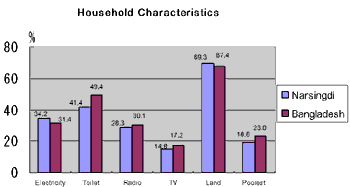
- Electricity : household with electricity
- Toilet : with sanitary toilet
- Radio : owning a radio
- TV : owning a television
- Land : owning more than 0.5 acres of land
- Poorest : poorest households (i.e. with the lowest wealth scores)
When it comes to the completion of primary and secondary education, however, Narsingdi is worse off than the national average.
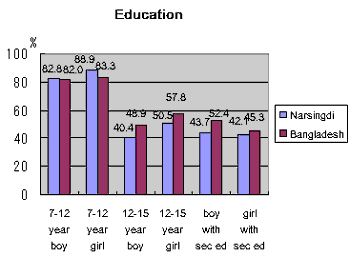
- Education : any education and primary education
- 7-12 year old : proportion of children aged 7-12 with any schooling
- 12-15 year old : proportion of children aged 12-15 who completed primary education
- boy/girl with sec ed : proportion of boys/girls aged 18-24 who completed secondary education
Maternal and Child Health in Narsingdi
Narsingdi is one of the poorly-performing districts in maternal and child health while its socio-economic development level ranks the middle in the country.
(probable causes of low MCH indicators in Narsingdi)
Particularly noteworthy is the high TFR and a low CPR despite the good access to the capital Dhaka.
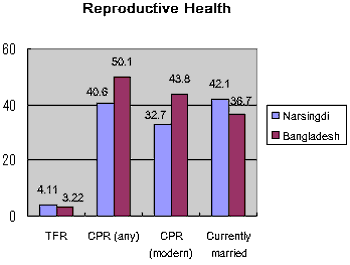
- TFR : Total Fertility Rate (age 15-49), i.e., a number of children that an average woman bears in her lifetime
- CPR (any) : Contraceptive Prevalence Rate (any method, age 13-49, %)
- CPR (modern) : Contraceptive Prevalence Rate (modern method, age 13-49, %)
More women in Narsingdi receive antinatal and postnatal care than the national average, but their delivery is less assisted by skilled birth attendants.
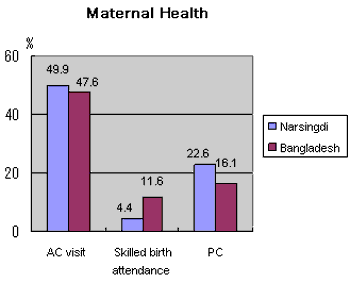
- AC visit : antenatal care visit (at least one visit, %)
- Skilled birth attendance : delivery assistance by medically-trained personnel (births in last three years, %)
- PC : postnatal care for mother (births in last three years, %)
Narsingdi has a higher IMR, which keeps the U5MR higher than the national average as well. In other words, reducing the IMR in Narsingdi will ultimately contribute to reducing the national IMR and U5MR.
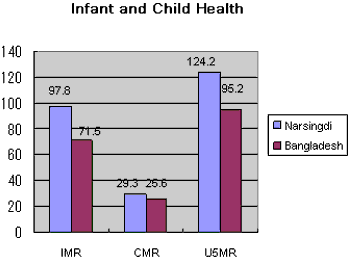
- IMR : Infant Mortality Rate (death before the fist birthday per 1000 live births)
- CMR : Child Mortality Rate (death between the first and fifth birthdays per 1000 children surviving to the first birthday)
- U5MR : Under Five Mortality Rate (death before the fifth birthday per 1000 live births)
